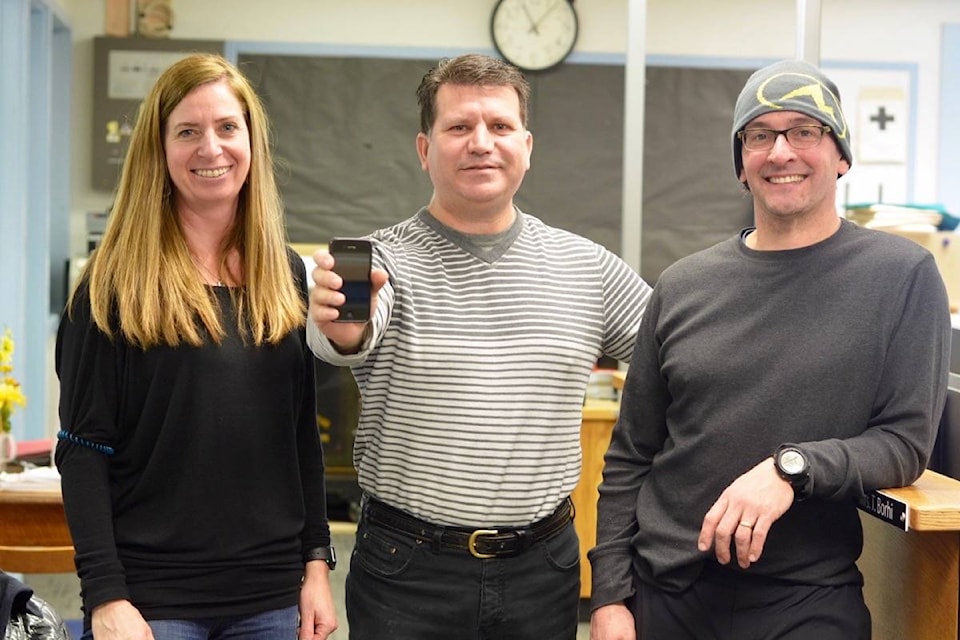For two weeks in January, all classes at Trafalgar Middle School took a digital device holiday.
Students were not allowed to have smartphones in classrooms. That’s already the case for some classrooms at the school, but principal Carol-Ann Leidloff thought students and teachers needed to hit the refresh button.
“We have a digital device policy that has been in place for about three years,” she said. “But every so often teachers find they are struggling to enforce it more than other times. Just before Christmas the Grade 8 teachers found they were constantly telling their students to use their devices in appropriate ways, and not during class time when they should be listening or working on an assignment. So this was a way of reminding students about the digital device policy.”
The policy states that use of phones in the classroom is at the discretion of the teacher. Each classroom has a simulated traffic light above the door in the hallway. Red means no devices in the classroom. Yellow means at the teacher’s discretion. Green means there are no restrictions. All common areas such as hallways and the library are green.
In classrooms designated as yellow a teacher might allow or ask students to use the phone for a specific research or technical purpose, then tell them to put them away again. Those who don’t have phones can use the school’s iPads or laptops.
There is a system of progressive discipline for helping students follow the policy, involving warnings, putting the phone in the receptacles like the Tech No Bin or the Cell Hotel or in the office, and ultimately, if all else fails, a call to parents to come and pick up a confiscated phone. This last option happens two to three times a year, Leidloff said.
During the digital device holiday, all classrooms were designated red. Teacher Jesse Anast said it was very easy to get each class started.
“It was excellent,” he said. “Kids were ready to learn. Instead of kids on their devices with headphones plugged in, it was great because there was just no devices. I could just start the class.”
Teacher Marcello Piro said it was a good opportunity for students to learn self-control.
“They were not being drawn to the vibrations of the phone. It was definitely more peaceful and quiet.”
But Piro thinks it should not be up to him to decide what students do with their phones. He’d rather educate them about that.
“I would like kids to learn how to manage the self control part of it, when is the appropriate time and when not, without another person having to remind you of that.”
Anast said many students know it’s a problem.
“A kid said today, ‘Mr. Anast you have to teach us about devices, you need to take it away and remind us that it is not appropriate.’”
He said the device holiday leveled the social playing field as some students don’t have phones because they can’t afford them or their parents won’t let them bring them to school.
Leidloff said she wants the school to teach students to use the devices in appropriate ways.
“We don’t want to be policemen and we don’t want to be rigid around rules. We want students to build their capacity to self-monitor and regulate device use independently.”
Are phones in the classroom an impediment to learning?
“It depends on the student,” Leidloff says. “Some students seem to be able to make good judgments about this, and others, when not provided with clear boundaries, are not able to regulate their device use and they find they are constantly distracted.”
Or as Grade 8 student Brodie Foley told the Star, “The phone is like power. If you have that kind of power you have to be careful to use it correctly. Because it can help you or work against you. You have to trust that you won’t get off task.”
Neither Foley nor Maeghan Reilly, another Grade 8 student, have phones.
“You don’t need a phone. You are there to work,” Reilly said. “It is crazy, how much a phone can take you away. People get so distracted and they don’t get any work done, just because of this little technology box.”
Anast thinks you can manage a classroom without devices but he’s not sure he wants to try.
“You could get by. But I am pro-device because they are useful and it is a tool they are going to use for the rest of their lives. I will keep using it for educational purposes for sure.”
Part 3 in our series phones in the classroom runs on Friday.
